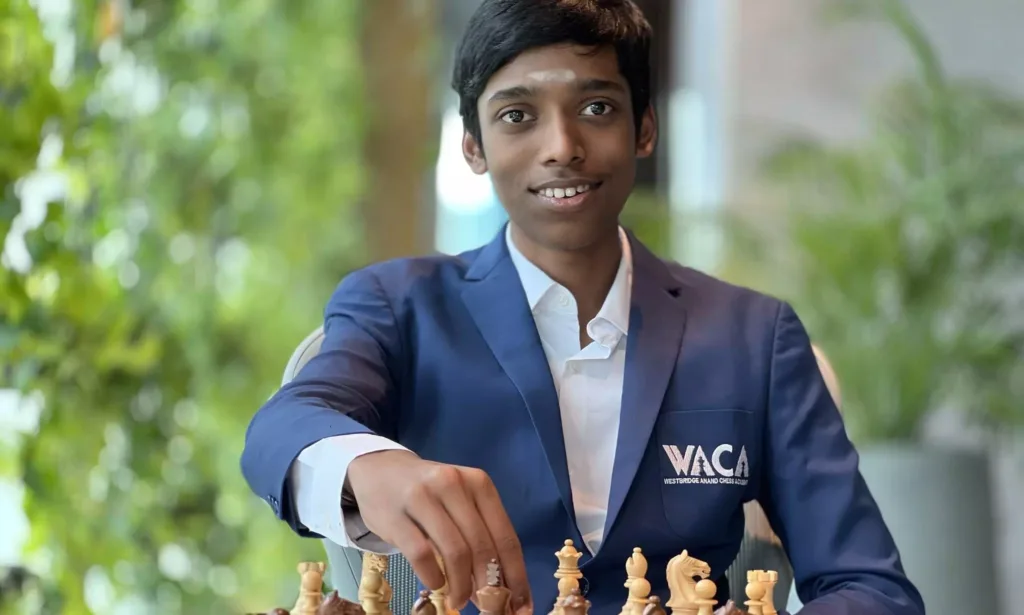At just 19 years old, Rameshbabu Praggnanandhaa, better known as Pragg, has already become India’s top chess player and climbed to World No. 4. But beyond his accolades, what truly sets him apart is his distinctive playing style: one that marries intuition, aggression, and increasingly, all-around maturity. His evolution as a player reveals a blend of raw talent, intense preparation, and a bold strategic mindset.
Aggression with Instincts to Match
From a young age, Praggnanandhaa’s style has leaned toward initiative and risk-taking. His long-time coach, R.B. Ramesh, said it best: “He is good in aggressive positions, where he is attacking and taking risks. That is his strong point.” This aggressive instinct was on full display during his memorable wins against Magnus Carlsen in 2023, where he consistently applied pressure until even the world’s best faltered.
Former Indian GM Dibyendu Barua agrees: “It is good to take risks at this age… whenever there is a possibility, you should go for a win.” This early habit of pushing for victories, rather than settling for safe draws, has helped Pragg develop the courage and sharpness required to challenge elite players.
But aggression doesn’t mean recklessness. Pragg’s play is underpinned by something less flashy but equally lethal: intuition.
A Natural Intuitive Player
In a recent lighthearted interview, grandmasters Anish Giri and David Howell evaluated Praggnanandhaa’s playing style using a “FIFA player card” format, assigning numerical ratings to his various strengths. The discussion revealed as much about Pragg’s style as it did about how his elite peers perceive him.
Here’s how the card rated Pragg:
- Calculation: 92
- Strategy: 88
- Time Management: 83
- Intuition: 87
- Defence: 82
- Overall: 91
Giri, however, had his own tweaks in mind. While acknowledging Pragg’s association with renowned calculation-focused coach R.B. Ramesh, Giri suggested flipping the scores for calculation and intuition. “I think he’s more of an intuitive player,” he said, emphasizing that while Pragg can calculate deeply, his real strength lies in feel and positional understanding.
Giri also downplayed the “time management” score of 83, arguing that although Pragg has occasionally run into time trouble, especially in risky games, it hasn’t been a critical weakness. “I wouldn’t think time management was the main issue,” he noted.
On defense, Giri made an interesting observation: “Pragg doesn’t strike me as a big defender because he’s very well prepared. People who are well prepared don’t end up in those kinds of positions.”
The Dutch GM concluded that Pragg is “a very well-rounded player without clear weaknesses” and deserves a strong 91 overall rating, firmly placing him in the “established world-class” tier.
“Out of Gukesh, Arjun, and Praggnanandhaa, I see myself the most in Pragg. His style, the way he approaches the game reminds me a lot of how I used to play.” – Magnus Carlsen
Positional Maturity and Strategic Growth
While his early reputation centered around tactics and initiative, Pragg’s strategic understanding has matured significantly, especially since the pandemic. GM Srinath Narayanan, who has tracked his progress closely, observed: “His game has stabilised a lot… Now he has a very impressive opening preparation. He is constantly finding new ideas everywhere.”
That’s no accident. Ramesh and Pragg have worked intensively to plug earlier gaps in his game, especially in quiet positional setups. “We are trying to make him better at playing quiet, simple positions without taking risks,” Ramesh said. “At the higher level, you need to be good at everything.”
This push toward balance is what makes Pragg dangerous today. As Anish Giri put it, he’s become “a very well-rounded player without clear weaknesses.”
Time Management and Defense: Still Developing
In his assessment, Giri rated Pragg’s time management at 83, suggesting it’s an area with room for refinement. “I wouldn’t think time management was the main issue,” Giri added, but he hinted that Pragg sometimes takes risks that lead to time trouble.
Interestingly, Giri also noted that Pragg isn’t often in defensive positions. “People who are very well prepared don’t end up in many [bad] positions,” he said. That preparation helps Pragg avoid needing to rely on passive defense, a reflection of his proactive approach to the game.
The Talent Factor: Hikaru’s Perspective
When Hikaru Nakamura sized up India’s rising stars, he didn’t hold back: “If you look at Pragg… in terms of pure chess talent, Prag stands out to me as the best.”
That’s a heavy compliment from one of the game’s sharpest minds. Pragg isn’t just another well-trained grandmaster, he has something innate. A feel for the board. A hunger to win. A sixth sense in complications.
Conclusion
Praggnanandhaa’s style is no longer just that of a fearless prodigy. He’s evolving into a complete player, dangerous in complications, sturdy in the endgame, unpredictable in openings, and increasingly strategic in quiet positions.
He’s intuitive, aggressive, and remarkably self-aware. As his 2025 run of titles shows, from Tata Steel to UzChess Cup, these changes aren’t theoretical. They’re winning him games, trophies, and respect.
In short: Pragg is no longer just one to watch. He’s one to fear.

I’m Xuan Binh, the founder of Attacking Chess, and the Deputy Head of Communications at the Vietnam Chess Federation (VCF). My chess.com and lichess rating is above 2300. Send me a challenge or message via Lichess. Follow me on Twitter (X) or Facebook.


3 thoughts on “Understanding Praggnanandhaa’s Playing Style: The Rise of a Relentless All-Rounder”
Comments are closed.